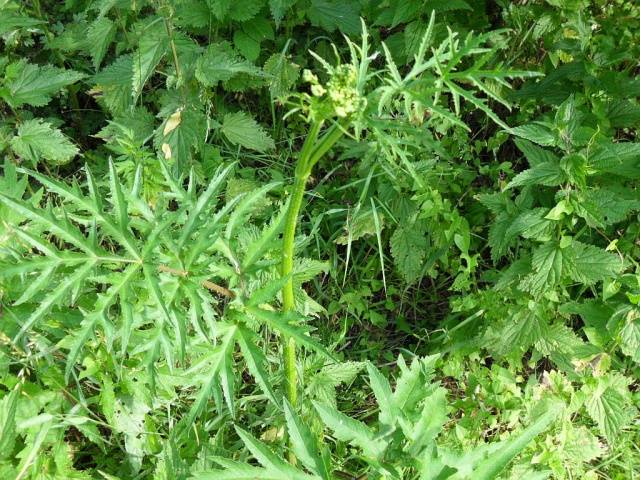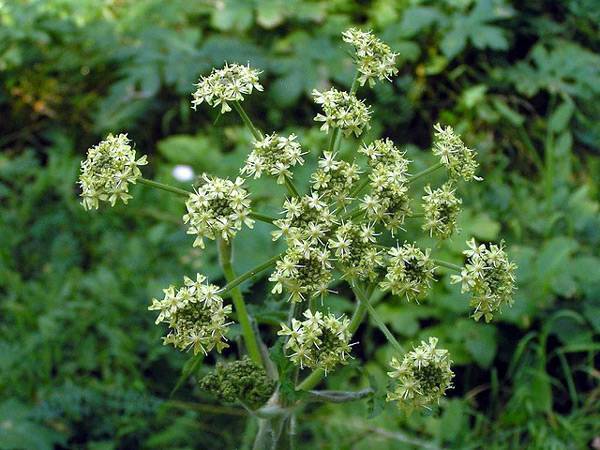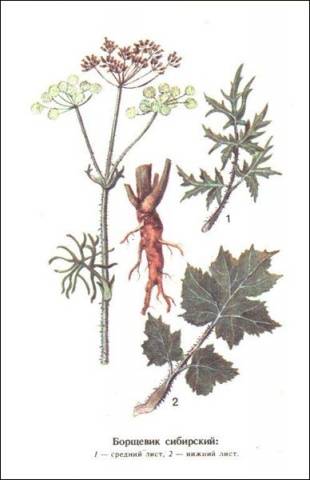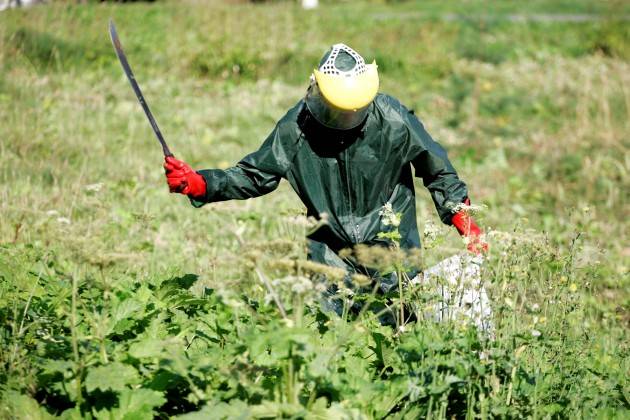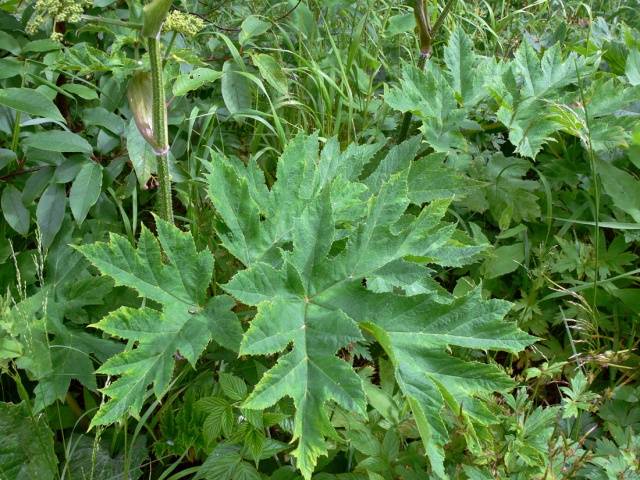Content
Hogweed Siberian belongs to the umbrella plants. In ancient times, it was often used for cooking, as well as in folk medicine. But not everything is so simple with this large plant. If mishandled, it can seriously harm human health.
Description of Siberian hogweed
Like other umbrella plants, hogweed can grow for 2 or more years. The stalk of a hogweed can grow up to 1.5 m in height. It resembles a thick, empty pipe. The lower part of the stem is covered with hard and long hairs. Lateral branches can rise above the main stem. The leaves are also very tough, large and pinnately dissected. They are located near the roots of the plant (5 or 6 pieces). Each sheet can be up to 40 cm long and about 25 cm wide.
The inflorescences form a complex umbrella, the diameter of which is at least 7 cm. The small umbrellas included in it have a diameter of up to 2 cm. The size of the blossoming flowers is about 40 mm in diameter. The hogweed fruit is a dry droop. You can see the inflorescences of this plant in the photo below.
Siberian hogweed grows in Europe. It can often be found in Western Siberia and the Caucasus. The best place for him is a forest meadow, thickets, areas near the road and water bodies. The plant loves moisture, therefore it is rarely found in the fields. Basically Siberian hogweed refers to unpretentious plants. It feels great both in shady places and in moist soil, where many more delicate plants die.
Both the leaves and the stems of this plant are composed of:
- resin;
- essential oil;
- coumarins;
- phenol.
In addition, Siberian hogweed contains a large amount of minerals such as boron, iron, titanium, nickel, etc. It also contains large amounts of ascorbic acid and carotene. The green mass of the plant contains about 17 different amino acids.
Application in medicine
Absolutely all parts of the plant have a certain healing effect. For the use of hogweed in medicine, it is important to properly collect and store the plant. Leaves are harvested before flowering. They should be dried, turning them over from time to time. Rhizomes must be dug out in the fall. Then the prepared roots are dried and then dried at 40 ° C. This raw material should be stored in glass containers. Rhizomes retain their beneficial properties for 3 years, and leaves only up to 2 years.
Hogweed infusions are used as an anti-inflammatory agent. In addition, it has antispasmodic and antiseptic properties. They are used to treat diarrhea, seizures, climatic syndrome, and impaired digestion. Siberian hogweed was also used to increase appetite. Adherents of traditional medicine claim that hogweed leaves do an excellent job with joint inflammation and rheumatism. For the treatment of eczema and neurodermatitis, cow parsnip is taken internally and externally. The roots of this plant are saved from cholelithiasis and jaundice. They are also used to treat bronchial asthma.
Here's how to prepare an infusion of hogweed roots:
- 1 teaspoon of chopped root must be poured with 1 glass of boiling water.
- The mixture is allowed to stand for about 8 hours.
- Further, the infusion is filtered and poured into a prepared container.
This infusion should be taken 20 minutes before meals.In the same way, you can prepare an infusion of hogweed leaves. Remember to follow the dosage and prescription exactly to get the therapeutic effect. Otherwise, the treatment either, in general, will not give any results, or even harm your health.
A decoction of rhizomes can also be used to treat stomatitis and sore throats. In this case, the resulting broth is used to rinse the mouth. There are other recipes for preparing medicines based on different parts of this plant. But nevertheless, it should be remembered that with serious illnesses, you must immediately consult a doctor. Traditional methods are not suitable for everyone.
Cooking applications
The name of the plant itself suggests that it was previously used to make borscht. In Russia, he was a frequent guest at the table. Young stalks of hogweed were used as a filling for pies, and the leaves were often added to various salads and side dishes. Those who have tasted them claim that such leaves are very similar to ordinary carrots.
The stems can also be eaten raw. To do this, they should be peeled and scalded with hot water. You can also boil or roast the stems. But, most often they were used to make jams and marmalades. Thanks to the sweet taste, sugar was even made from the stems.
Leaves and rhizomes were taken to prepare borscht. They are in no way inferior to vegetables in terms of nutritional value. The inflorescences of this plant have an extraordinary aroma that attracts bees. Because of this, Siberian hogweed Siberian can be called an excellent honey plant. True, this honey has an unusual taste and color.
Hogweed burns
Skin contact with hogweed juice can lead to serious burns. In some, they may appear in the form of mild itching, while in others, even large blisters form. Other unpleasant symptoms, such as headache and fever, may also appear. After the bubbles dissolve, bleeding wounds will remain on the body for a long time.
Most often, such manifestations are observed in young children with fair skin. They are most susceptible to hogweed juice, therefore they are at risk. Moist skin also contributes to skin irritation and the spread of sap from the plant.
Fight against Siberian hogweed
This plant is capable of spreading very quickly, capturing new territories. It grows rapidly, displacing other plant species from the site. Such a rapid growth is also explained by the fact that the cow parsnip is able to self-pollinate and quickly form seeds. For example, the Sosnovsky hogweed in some areas has grown so much that it began to threaten the health of residents. Many gardeners and gardeners have been struggling with this plant for years.
The most important thing is to have time to remove the young sprout before the seeds appear. Experience shows that for several years it will be necessary to constantly mow the plant at the initial stage of development. This is the only way to get rid of this "enemy". Remember the safety measures. Removal of sprouts is carried out only in seals and protective clothing. If, nevertheless, the juice managed to get on the skin, you must immediately wash it off with soapy water. The Siberian hogweed is not so dangerous, but the fight against it will be no less lengthy.
Interesting Facts
Many people confuse different types of hogweed. Outwardly, it can be really difficult to spot the differences. The following hogweed can grow on the territory of Russia:
- ordinary;
- Sosnovsky;
- bearded;
- woolly;
- dissected.
Not all of them are equally dangerous. For example, Siberian hogweed is practically harmless in comparison with Sosnovsky, which can lead to disastrous consequences for human life and health.The main difference can be seen on the leaves of these plants. Siberian hogweed has strongly dissected leaves of a muted green color. They are slightly velvety and rough. It rarely grows more than 1.5 m, while Sosnovsky often reaches 3 meters in height.
Conclusion
Probably, few plants can cause such split feelings in us. On the one hand, hogweed is an excellent drug that fights against many diseases, on the other hand, it is a dangerous enemy that grows at a tremendous speed throughout the area, preventing other plants from developing. Plus, it can harm our skin. In any case, the Siberian hogweed is not as dangerous as its closest "relatives". If used correctly, it will only be beneficial.
